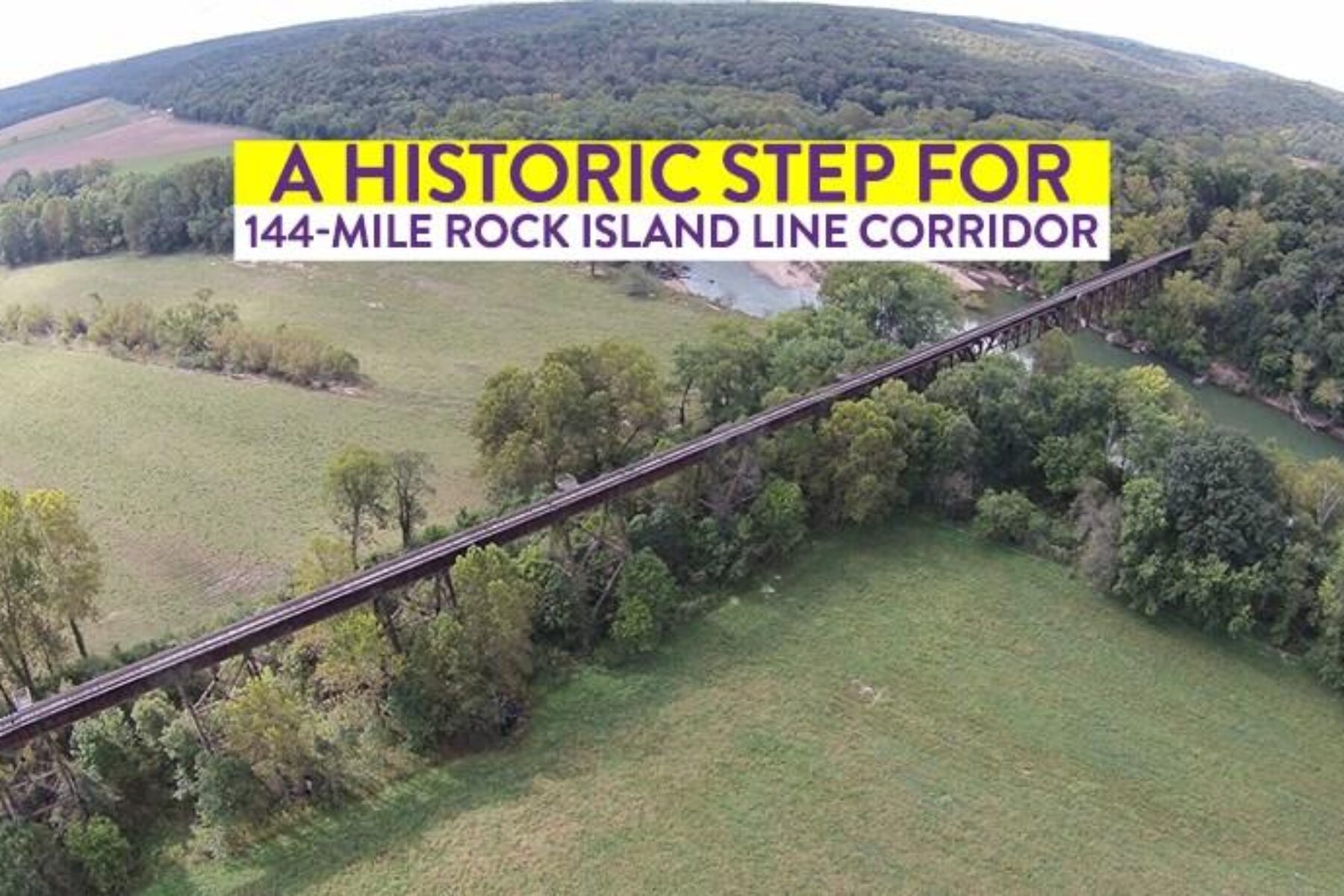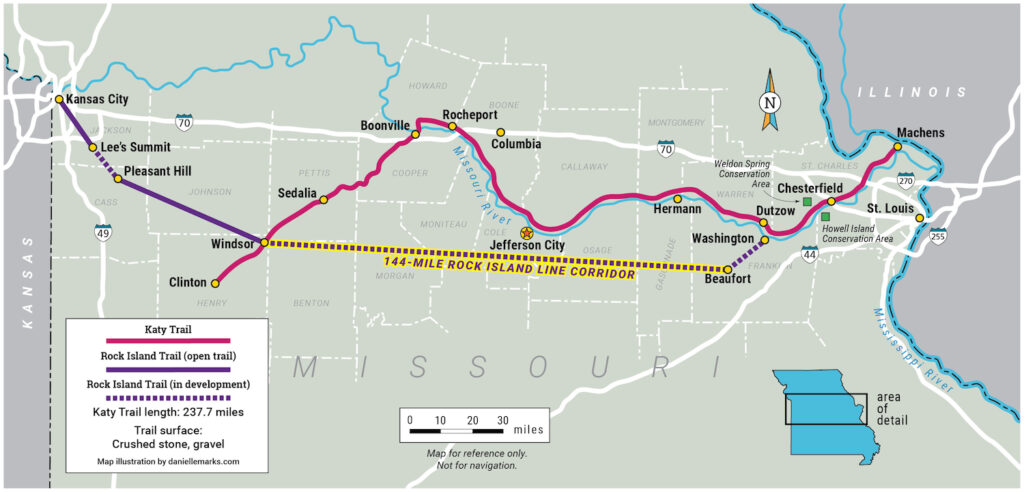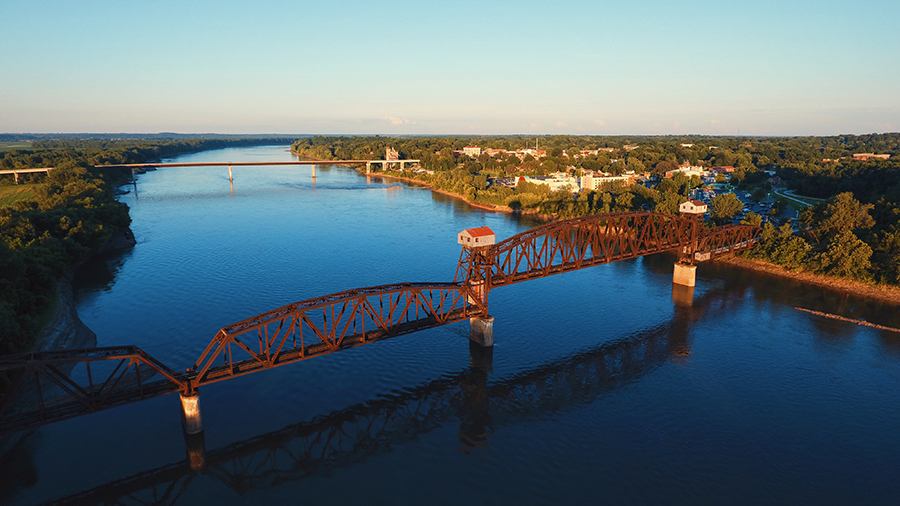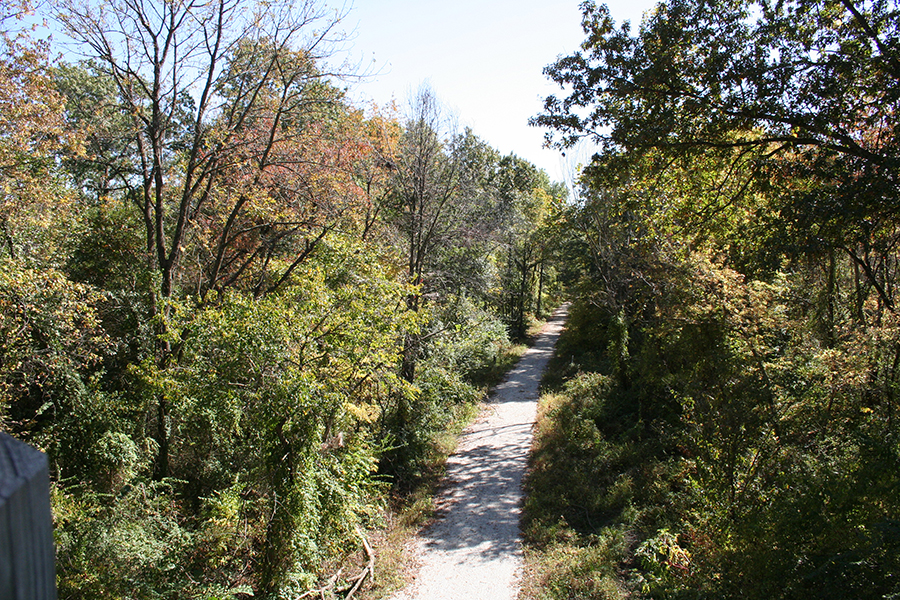Breaking News: The Rock Island Trail Is a 144-Mile On track to Be Game-Changer for Missouri

12/14/21 Update:
On Dec. 14, 2021, advocates for the Rock Island Trail celebrated as Gov. Mike Parson announced that the state of Missouri would officially take ownership of the 144-mile Rock Island Railroad corridor between Windsor and Beaufort, Missouri. The governor’s announcement, which comes after decades of advocacy and negotiations, marks the final step in railbanking the corridor, which is now destined to be preserved—and enjoyed—as a trail.
All along a 144-mile stretch of Missouri’s old Rock Island Line, rural communities formerly known as railroad towns have been looking forward to a new possibility: a multiuse trail that would revitalize the long-unused train tracks.
As the idea of the Rock Island Trail has gained steam in recent years, small central-Missouri towns have gone into preparation mode—from Owensville’s hopes of using the trail for a safe route to school, to Belle’s move toward a community improvement plan along the corridor, to a plan for senior-living housing in Eldon.
“There are 23 communities between Beaufort and Windsor, and most are railroad towns,” said Owensville resident Chrysa Niewald, past president and current board member of the Missouri Rock Island Trail, Inc. (MoRIT). With the railroad tracks lying unused for the past 30 years or so, many of those towns have embraced the idea of putting the old railbed to use as a trail for bicycles, pedestrians and equestrians.
“A railroad would be great, but that’s probably not going to happen,” Niewald said. “A trail would be the next best thing.”
“We’ve been talking about this since the 1980s, and it’s within our grasp.“
—Brent Hugh, executive director of the Missouri Bicycle and Pedestrian Federation
Within Our Grasp

And in fact, the pieces have been falling into place in recent years for the vast new rail-trail section.
The planned Rock Island Trail would intersect the Katy Trail, a popular 240-mile rail-trail route that traverses the rolling terrain along the Missouri River. It also would link up with a recently opened 47-mile segment, the Rock Island Spur of Katy Trail State Park, which connects the Katy Trail to the greater Kansas City area. In all, supporters envision a loop of nearly 400 miles that would span the entire state, from Kansas City to St. Louis.
In 2015, the project took a dramatic leap forward when the Ameren utility company, owners of the railbed, agreed to donate 144 miles of the Rock Island Line to the state of Missouri to be used as a recreational trail. Removal of the railroad tracks and ties has been underway, and the transfer of the railbed was expected to happen as soon as that work was complete. A number of partners, including Rails-to-Trails Conservancy (RTC), have been helping to guide the project.
“This trail has the potential to become a destination-tourism powerhouse in the region and serve as a national example of how these pathways can benefit communities economically and culturally,” said [former] RTC President Keith Laughlin. “It’s fitting that a state crucial to the early rail-trail movement now has the opportunity to help lead the way for trail systems of the future.”
“We were overjoyed,” Niewald said of the news of the pending deal. “There were bumps along the way, but this was a win-win for all of the towns.”
Progress of the Rock Island Trail
- National Trails Community Celebrates Historic Railbanking of the Rock Island Corridor | 12/14/21
- State of Missouri Announces Historic Step for Future Rock Island Trail | 12/17/19
- Rallying for Missouri’s Rock Island Trail | 08/15/17
- Missouri’s Rock Island Trail State Park: Trail of the Month | 12/05/16
- Final Missouri Rock Island Trail Segment Confirmed in 450-Mile Trail Network | 10/01/15
- World-Class Trail Network in Missouri Just Got 47 Miles Closer to Reality | 09/23/15
- Missouri Rail-Trail Just Got One Giant Step Closer | 10/01/14
- Awaiting a Decision in Missouri, We Ponder the Great Possibilities | 09/11/14
- Opportunity Knocks in Missouri: RTC Steps In to Save 145-Mile Connection to Katy Trail | 08/04/14
Next Steps

With the start of a new state administration in 2017 came word that Missouri’s Department of Natural Resources would be taking a fresh look at the project. The announcement had those who have supported the rail-trail over the years emphasizing the importance of once again letting the state know the value of the Rock Island Trail.
“We’ve been talking about this since the 1980s, and it’s within our grasp,” Brent Hugh, executive director of the Missouri Bicycle and Pedestrian Federation, said in December 2018. Now, he said, the “number-one action” is for trail advocates to speak out in support of the trail.
In August, after nearly five years of enthusiastic support for developing the Rock Island Trail—including more than 30,000 public comments—the Surface Transportation Board approved a request to extend negotiations between Ameren and the state of Missouri with regard to railbanking the corridor to Dec. 31, 2019.
The results of these negotiations were cause for celebration by trail advocates and supporters throughout Missouri and the country when the state announced in mid-December 2019 that it had entered into an interim trail-use agreement with Ameren (via the Missouri Central Railroad Company)—marking a major step forward to transforming the disused rail corridor into a multiuse trail and asset for communities.
A “Virtual Gold Mine”

Along with its potential for connectivity in Missouri, the Rock Island Trail route has another major plus in its stunning setting. While the Katy Trail is largely about the Missouri River and the bluffs along the riverbed, Hugh said, “The Rock Island is much more rugged, with bridges and tunnels. It’s getting down into the Ozarks, so the terrain is diverse, with a lot of hills and valleys.”
Expected to be a major centerpiece of that section is Gasconade River Bridge, a quarter-mile trestle that soars over the river and continues on through the area’s hilly farmland.
For Greg Harris, executive director of MoRIT, the economic benefits figure in prominently as well. “This is something the communities want,” Harris said. “It will be a virtual gold mine for these small towns.”
When complete, the Rock Island Trail could serve as a multiplier for the economic benefits already generated by the Katy Trail, which receives 400,000 visitors each year and has an economic impact of more than $18 million.
As an example, supporters point to the community of Windsor, located at the crossroads of the Rock Island spur that opened in December 2016, and the popular Katy Trail. B.J. Friedly, executive director of the Windsor Chamber of Commerce, says the impact on tourism has been dramatic. The town campground has seen a 400 percent increase in bookings, for instance, and other overnight accommodations and dining establishments have also seen benefits.
Eric Oberg, director of trail development for RTC’s Midwest Regional Office, says the sheer uniqueness of the Rock Island opportunity stands out. “You don’t see 144-mile corridors anymore,” he said. “This isn’t just an amazing opportunity for Missouri, it is nationally and internationally significant. It would be a way for Missouri to set itself apart.”
Indeed, Hugh calls the opportunity “a game changer”—one that he says would transform Missouri into an international destination.
This article was originally created for the Fall 2017 issue of Rails to Trails magazine. It has been published here in an edited format.

Donate
Everyone deserves access to safe ways to walk, bike, and be active outdoors.



